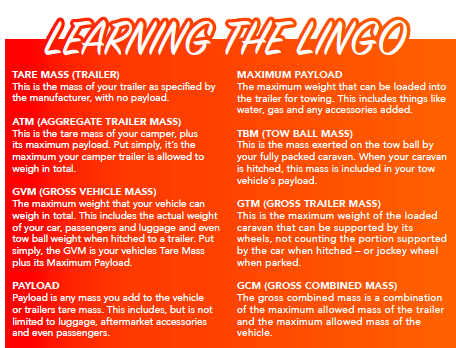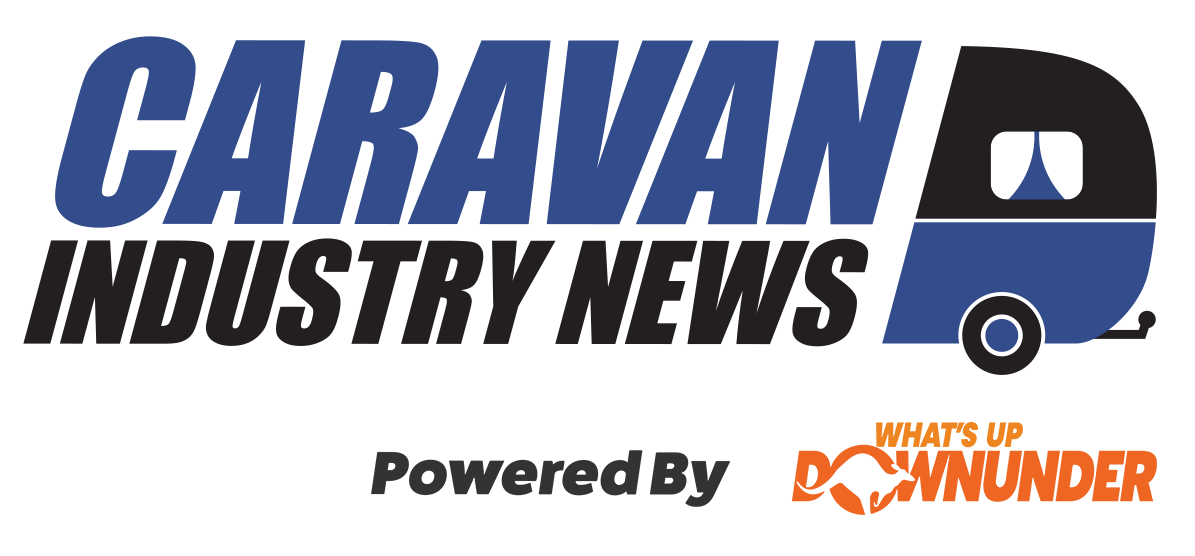Understanding Tow Weights – The War on Weight
Is your touring set-up a little on the obese side? Take a crash course on weight and the affect it can have on your vehicles handling
We aren’t afraid of stacking a few extra pounds onto our vehicles
Make no mistake, the average touring setup is heavier than it’s ever been before. Camper trailers are getting heavier, and our desire to take everything including the kitchen sink means we aren’t afraid of stacking a few extra pounds onto our vehicles, either. While your tow car may be able to pull a heavy load like a freight train with a bad attitude, have you ever spared a thought for the effects of all that extra weight? Heck, is your camper trailer even legally allowed to carry the kid’s bikes, the boat and fishing gear, along with half the contents of your home? Well, before you start loading up all of your adventure gear, there is more to consider than meets the eye.
Load Positioning
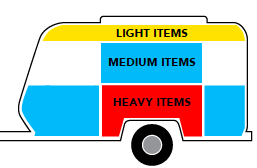 As every camper trailer design differs, so too does the way it reacts to extra weight being placed at different locations around its structure. Ultimately, to ensure towing stability the deciding factor is balance. Think of your trailer like a seesaw, with the axle and wheels being the centre pivot point. Adding too much weight to the rear of your camper is basically leveraged to reduce the weight on the tow ball. This can result in the trailer becoming unstable, especially at higher speeds. Excessive weight at the front places added weight to your vehicles tow ball, which can result in decreased braking capability, reduced steering quality, and poor overall stability. In most cases, it’s best to position any extra weight directly over the axles of your trailer, which is where the weight receives the least amount of leverage and is at its most centred.
As every camper trailer design differs, so too does the way it reacts to extra weight being placed at different locations around its structure. Ultimately, to ensure towing stability the deciding factor is balance. Think of your trailer like a seesaw, with the axle and wheels being the centre pivot point. Adding too much weight to the rear of your camper is basically leveraged to reduce the weight on the tow ball. This can result in the trailer becoming unstable, especially at higher speeds. Excessive weight at the front places added weight to your vehicles tow ball, which can result in decreased braking capability, reduced steering quality, and poor overall stability. In most cases, it’s best to position any extra weight directly over the axles of your trailer, which is where the weight receives the least amount of leverage and is at its most centred.
Loading Tips
1. Place bulkier items either directly over the axle or in front of it. Your trailer is much more likely to track straighter and maintain its stability.
2. As the front of your trailer is anchored to your tow ball, the rear of your camper is subjected to harsher movements, especially on rough terrain. So, if you’ve got fragile items on board, they’re safer up the front!
3. Positioning excessive weight at the front and rear of your trailer can create a seesaw effect, which can introduce handling and stability issues under tow.
Tow Bar and Coupling Specifications
Once you are satisfied your vehicle can safely and legally tow your camper trailer and any gear you throw on top, you’ll need to check a few other bits and bobs that are often forgotten about, too. Yep, you guessed it, the load limits of your towing apparatus should be verified as well. This includes your vehicles tow bar and the trailers coupling. If any of these components are rated too low, an upgrade will be required.
What catches most of us out is the maximum allowable tow ball weight, which can largely vary depending on the tow bar fitted to your vehicle.
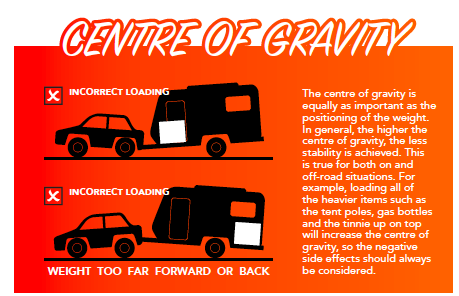
Overloaded Tow Tug
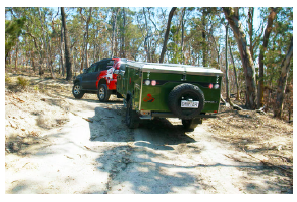 Modern tow vehicles are comfortable powerhouses, but you can’t always tell when you’re towing overloaded. You see, the old ‘nose up’ rule isn’t enough. Even if you can’t see or feel it, exceeding your vehicles’ towing weight limits is dangerous and damaging. The old myth that you can simply ‘sense’ if your vehicle is within legal weight limits is no longer applicable thanks to modern vehicles and their ability to mask handling feedback from the road.
Modern tow vehicles are comfortable powerhouses, but you can’t always tell when you’re towing overloaded. You see, the old ‘nose up’ rule isn’t enough. Even if you can’t see or feel it, exceeding your vehicles’ towing weight limits is dangerous and damaging. The old myth that you can simply ‘sense’ if your vehicle is within legal weight limits is no longer applicable thanks to modern vehicles and their ability to mask handling feedback from the road.
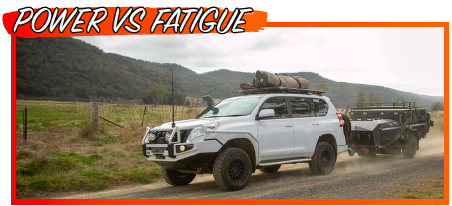
While power matters, towing ability extends beyond engine capacity. “Most vehicles now have more than enough power to pull a load heavier than it is rated to tow and a simple suspension upgrade can hide any visual cues like suspension sag.
The problem is, overloading your tow-tug takes a toll on pretty well everything. Your vehicle’s suspension bushes are normally the first to show signs of fatigue. However, excessive weight places your entire driveline under extra load. This can permanently mess with your chassis alignment. The other problem is individual components start to be pushed past their design limitations. Things like the towbar download limit are often exceeded, which presents a problem because most of us would like our caravan to stay firmly attached to the tow vehicle, right?
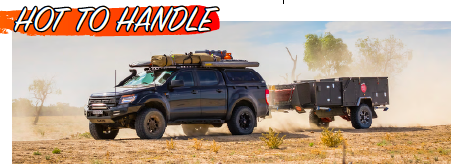
In the short-term, overloading creates all sorts of handling issues, including some that surface sporadically. You’ll find any unwanted characteristics are grossly exaggerated when your set-up is overloaded. A slight ‘kick’ to one side after hitting a pothole can easily develop into a full blown sway. A slighting unbalanced brake bias can progress into a violent pull to one side as you apply the brakes. Maintaining correct weight distribution is much harder, too, creating knock on effects behind the wheel in many ways. Too much weight over the back axle can cause the front axle/ wheels to lift, which can trigger a ‘floating’ feeling through the steering. This tends to make the vehicle ‘wander’ all over the road.
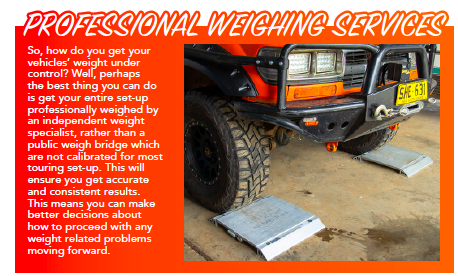
Top Tip – Shave a few kilos
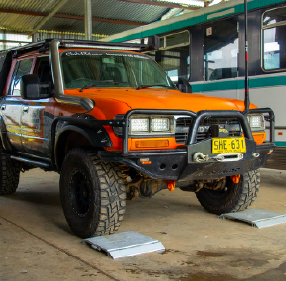 While a lot of people like to leave their 4WD and caravans set-up and ready for anything, Here’s another school of thought. Instead, try carefully selecting what you pack for each individual trip. You’d be surprised at how much weight you can save by simply being realistic about your requirements. For instance, there’s no point lugging that second 9kg LPG bottle around if you’re just going away for the weekend. Or maybe the annex canvas can be left in the shed this time around.
While a lot of people like to leave their 4WD and caravans set-up and ready for anything, Here’s another school of thought. Instead, try carefully selecting what you pack for each individual trip. You’d be surprised at how much weight you can save by simply being realistic about your requirements. For instance, there’s no point lugging that second 9kg LPG bottle around if you’re just going away for the weekend. Or maybe the annex canvas can be left in the shed this time around.
